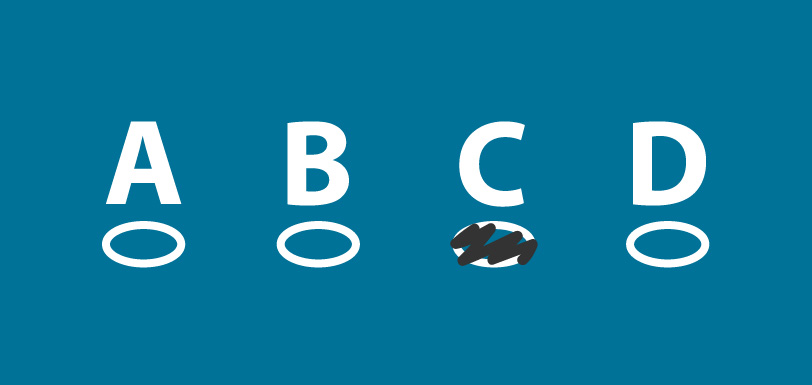Hello!
This tongue-in-cheek article from 2017 suddenly became the most-read post on LearnGeek for 2020, and I think I know why. If you found this article because your school or job went digital due to the pandemic and you’re trying to deal with more online classes and training, this probably isn’t what you’re looking for.
However, if you’re a learning professional or educator interested in designing better multiple choice assessments, keep reading.
Thanks for visiting LearnGeek!
I DARE every workplace learning pro to share the next section of this post with employees who have to complete one of your knowledge assessments.
How to beat your next multiple choice test!
- Don’t bother reading the questions.
Why waste time reading the questions? Just read the answer options and pick the only one that actually sounds like it could be possibly be the thing your company would want you to do. - Select the longest answer option.
The correct answer is usually the one with the most words because the assessment writer forced all of the corporate-sounding language into the response to get it approved by the subject matter experts. - Select all/none of the above when available.
There’s no reason to offer all/none of the above as an option unless it’s the correct answer. If this option is available, it’s either an unfair trick or a poorly-written question. - Just take it again.
Who cares if you pass the assessment the first time? Chances are that you’re allowed at least 2 attempts to get the required 100% passing score. And the retake will probably be the EXACT SAME TEST with the questions in a different order. Just make note of what you got wrong the first time and make different selections until you get the passing score.
Of course, these tips don’t work 100% of the time. Nonetheless, my 20+ years of experience writing and taking multiple choice tests tell me they’ll probably increase your chances.
So? Do you think sharing this information would cause more employees to pass your assessments on the first try? Well, I have news for you …
- They’ve already figured these things out.
- They’re probably saving and sharing the correct answers via Teams or Drive.
- You have an assessment design problem.
Assessments are important. They help us understand what people are/not ready to do at a particular moment in time. They also boost employee confidence in their readiness to perform their jobs. These considerations are especially important for new employees and in high-risk work environments.
Unfortunately, designing a GOOD assessment is VERY difficult. Many L&D pros wait until the end of a project to write the assessment. They have limited time to get it done and just end up churning out a generic set of multiple choice questions (MCQs), the number of which always seems to divide evenly by 5. MCQs aren’t the only option for creating a good assessment. Job tasks, behavior observations and simulations are all great tools. But good MCQs help us assess knowledge and capability in a fast and scalable way.
When L&D falls into the same question design traps over and over again, assessments turn from useful learning exercises into just more hoops employees have to jump through before they can get back to work.
Here are 7 tips for making your MCQs unbeatable (aka they’ll actually help people learn).
- Write the assessment first.
Your content should be working towards a measurable knowledge/behavior outcome. Therefore, you should write the assessment first. Then, use it as a guide for your content design to make sure employees can demonstrate the expected knowledge/behavior. - Eliminate true/false.
True/false is a 50/50 guessing game, not a realistic application of knowledge. They also tend to be trick questions anyway (which of the following is NOT … really?!?!?). Just don’t use them. - Lose all/none of the above.
What’s the point of all/none of the above? More often than not, it’s a lazy way to stuff a pile of different questions into one so you can stay under the arbitrary question limit. The correct answer is almost always all/none of the above. And, if that’s not the correct choice, it’s more of a trick than a realistic option. Nix it. - Challenge application, not trivia.
When was the company founded? You may think that’s important information every employee should know, but does it help them do their jobs any better – especially when they’re new? Don’t turn workplace learning into a trivia game. Use assessments to challenge employees’ ability to apply their knowledge to solve real-world problems. - Vary the questions.
Your employees are passing around the answers to the test because they know they’ll all receive the same questions in a different order. Vary the questions themselves as well as the sequence and response options. Ultimately, any assessment that isn’t manually proctored can be gamed. But this approach it makes it a lot harder and less worth the effort. Plus, problems in the real-world don’t show up in a predictable order or with consistent response options. - Set realistic passing scores.
Requiring employees to get 100% to pass an assessment promotes cheating and gaming. Think about it. What would you do if your job was on the line or if you would get in trouble with your manager? Instead of trying to really learn the topic, you’d probably do whatever it took to get past the test … while also developing a negative opinion of workplace training. Perfection is not the goal. A good assessment is part of an overall learning strategy that promotes feedback and coaching to help people identify and close their knowledge/skill gaps. - Use questions for learning.
Questions should not be limited to assessments. Questions are an extremely effective learning tool. They are a great way to leverage core learning science principles, including retrieval practice. This is why flash cards are so nifty. Rather than making your employees fear questions because they’re always used to test (pass/fail), use questions for what they’r really good for: challenging knowledge to help people learn. After all, which test questions do you remember from school: the ones you got right or the ones you got wrong?
How are you using multiple choice questions? Do you write questions just to test knowledge or to also help people learn? What’s the worst multiple choice fail you’ve ever seen?



